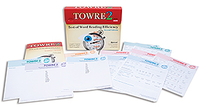TOWRE-2 Test of Word Reading Efficiency-Second Edition, Complete Kit
TOWRE-2 Test of Word Reading Efficiency-Second Edition, Complete Kit
Ages: 6-0 through 24-11 years
Testing Time: 5-10 minutes
Administration: Individual
The Test of Word Reading Efficiency (TOWRE) was originally published in 1999 to meet the need for a quick and reliable way to assess efficiency of sight word recognition and phonemic decoding in children and adults. Its purpose was to provide professionals in schools and clinics with a reliable and valid measure of fluency and accuracy of print-based word-reading skills.
Since its publication, the TOWRE has been popular with professionals in psychology and education. It has been featured in over 200 research reports focusing on various aspects of reading and language development in normal and clinical populations. The test received two positive reviews in the Mental Measurements Yearbook, and has been discussed in numerous books and articles devoted to current assessment practices for schools and clinics.
Changes to the TOWRE-2
All new normative data were collected in 2008 and 2009. The demographic characteristics of the sample conform to those of the population reported in the Statistical Abstract of the United States and are, therefore, representative of the U.S. population.
Additional word lists have been added to both TOWRE-2 subtests, so that each of them now has a total of four equivalent forms. This will make the test more useful for monitoring progress and evaluating the impact of instructional interventions. Along with the new forms of each subtest, the manual presents extensive information required to evaluate the educational and statistical meaning of changes in performance that may occur from one testing to another.
The manual has been extensively revised and provides much new information about the validity and reliability of the TOWRE-2. Data from numerous independent research studies have been aggregated to provide strong evidence for the construct validity of the TOWRE-2 as well as its utility in diagnostic assessments of children with reading disabilities and other handicapping conditions. Extensive data are also reported in easy-to-access tabular form to show how each of the subtests of the TOWRE–2 is related to other prominent tests of reading skill.
Description of the TOWRE-2
The Test of Word Reading Efficiency-Second Edition (TOWRE-2) is a measure of an individual's ability to pronounce printed words (Sight Word Efficiency) and phonemically regular nonwords (Phonemic Decoding Efficiency) accurately and fluently. Because it can be administered very quickly, the test provides an efficient means of monitoring the growth of two kinds of word reading skill that are critical in the development of overall reading ability.
Each of the two subtests of the TOWRE-2 has four alternate forms, A through D. The Sight Word Efficiency (SWE) subtest assesses the number of real words printed in vertical lists that an individual can accurately identify within 45 seconds. Similarly, the Phonemic Decoding Efficiency (PDE) subtest measures the number of pronounceable nonwords presented in vertical lists that an individual can accurately decode within 45 seconds. The four forms of each subtest are of equivalent difficulty, and any of the forms of each subtest may be given depending on the purposes of the assessment. If only one form of each test is used, the test can be administered in approximately 5 minutes, including time for directions and practice items.
The TOWRE-2 was normed on over 1,700 individuals ranging in age from 6 to 24 years and residing in 12 states and Washington, DC. Over 700 children in the norming sample attended elementary school (through Grade 5), where the TOWRE-2 is expected to have its widest use. The average alternate forms reliability coefficients (content sampling) for the subtests exceed .90. The average test-retest (time sampling) coefficients for the same form exceed .90. The average test-retest (time sampling) coefficients for different forms of the subtests are .87. The magnitude of the coefficients reported from all the reliability studies evidenced little measurement error in the TOWRE-2. The numerous reliability and validity studies presented in the manual provide the examiner with strong evidence concerning the strengths and limitations of the scores provided by the test.
Uses for the TOWRE-2 The current edition of the TOWRE has been widely used for three different purposes:
- Early identification. The TOWRE-2 can be used in identifying children in the early elementary grades who will require more intensive or explicit instruction in word reading skills in order to make adequate progress in learning to read.
- Diagnosis of reading disabilities. The test is also being widely used as part of a battery of tests for diagnosis of specific reading disabilities in older children and adults. The TOWRE-2 can be used either as a replacement for or as a supplement to standard diagnostic tests of context-free word reading ability currently in use.
- Research. Since its publication in 1999, the TOWRE has been widely used in research as a quick and reliable assessment of word-level reading skills in both large and small research populations.
We hope that the TOWRE-2, with the creation of two additional test forms (Forms C and D) for each subtest, will have at least one additional use beyond those already enumerated. The report of the National Reading Panel in 2000 indicated that frequent monitoring of growth in essential reading skills is important in the delivery of effective reading instruction for all students. Frequent assessment of critical reading skills is also a central aspect of the popular Response to Intervention model of service delivery. Although the TOWRE-2 has not been developed to provide weekly or monthly assessments, it certainly can be used to monitor progress in growth of word-level reading skills three or four times per year.
Complete TOWRE-2 Kit Includes: Examiner's Manual, Form A Word Cards, Form B Word Cards, Form C Word Cards, Form D Word Cards, 25 Form A Examiner Record Booklets, 25 Form B Examiner Record Booklets, and 25 Response to Intervention Booklets, all in a sturdy storage box.
�2012 � Previous Edition: #8920



